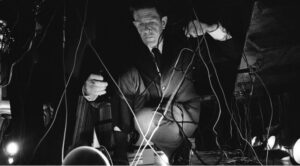
A number of years ago I was doing research on Anthony Davis’s X: The Life and Times of Malcolm X (1985) at the archives of the New York Public Library when I came across an intriguing clause in a contract for the various organizations producing the opera. “The word ‘jazz’,” it read, “should not be used in any connection with this piece, including [in] Anthony Davis’s biography.” (I have received Davis’s approval to use the word here.) Though Davis had emerged as a young musician in the mid-1970s in what has often been referred to as the New York avant-garde jazz scene, his resistance to the term “jazz” was neither uncommon within that milieu nor unprecedented. Many musicians—and African-American musicians in particular—who have been regarded as major jazz innovators have been troubled by the word (Duke Ellington, Miles Davis, Anthony Braxton—the list goes on). The label jazz has been seen as an attempt to pigeonhole and constrain musical creativity, a racist term of disparagement, and a way of erecting borders between “high art” and entertainment. In the case of X, Davis was particularly wary of the label “jazz opera” that was sometimes bandied about in the press. X, he firmly stated, was a “real opera.”
No argument here. Not only is X clearly a real opera according to even the most conservative criteria (e.g., sung throughout by operatically-trained voices), it is a remarkable one. Still, X is obviously in dialogue with the great constellation of musicians and styles that, for better or worse, have been called jazz. Davis himself is clear on this count, and has even pronounced that tradition the most promising source from which to develop a distinctly American opera. And in a sense, I would argue, X is an opera not only partially derived from but about (among many other things) that tradition. This is most obvious in those episodes where historical styles are inventively reworked: the allusions to Ellington’s lush, subtly shaded harmonies, and nods to some of his band’s famous soloists (e.g., trombone pioneer Joe “Tricky Sam” Nanton), in act I, scene ii; the Cab Calloway-esque strains of character Street’s virtuosic scatting later in that scene (originally sung by the fantastic Thomas J. Young); the invocations of John Coltrane’s sacred-ecstatic sound of the ‘60s in the Allahu-Akbar chorus of act II, scene i (which includes, tellingly, soprano and tenor saxophone solos—Coltrane’s principal instruments). But X is also about this tradition in a more pervasive, if subtler, sense. To understand its message, we must take into account Davis’s whole, rich musical language—one that draws on African-American music as well as Richard Strauss, Balinese gamelan, Igor Stravinsky, minimalism, and much else besides, while always remaining unmistakably his own.
Rhythm/Composition
Anyone encountering X for the first time is bound to be struck by its rhythmic dynamism, the abundance of hard-driving pulsations that are nevertheless notably elusive (difficult to count, ornately layered, loopy). Sometimes different groupings of beats (i.e., “meters”) are superimposed: 4 against 11, 5 against 7, that kind of thing. But Davis takes this polymetric principle much further. The groupings might be longer; they may gradually evolve; they can take a long time to come in and out of step with one another; they may be associated with specific sets of pitches or intervals to form recurring motives. And then there are the expansive melodic lines, both vocal and instrumental, that seem to “float” above the pulses.
Davis developed this characteristic sound-world in a series of compositions for his Episteme ensemble in the late 1970s and early 1980s that were influenced by Balinese gamelan music, especially the gender wayang style. He once clarified that it was never a matter of “imitating” gamelan music but rather of having become “inspired to look at [his] own musical tradition in a different way.” Specifically, I think, the vast rhythmic constructions of gender wayang helped Davis perceive in the complex rhythms that were already a part of many African-American styles a basis for generating large-scale compositional forms (using some of the techniques mentioned above). It seems no coincidence that Davis titled one of the gamelan-inspired movements from his Hemispheres suite (1982)—some of which makes its way into X—“Little Richard’s New Wave.”
This insight about rhythm as form-generating was also one way of addressing a musical issue that had preoccupied Davis since the beginning of his career: the relationship between composition and improvisation in African-American music. Davis has often said that Duke Ellington represented a high point in their synthesis. But, he maintained, since then—from bebop through free jazz and its progeny—the development of compositional “structure” had tended to take a backseat to improvisation (Davis counted Mingus and Thelonious Monk as among the important exceptions in all this). The pieces for Episteme were meant to reclaim and build on this often overlooked compositional legacy, one that did not, however, exclude more recent approaches to improvisation. Something similar could be said of Davis’s treatment of Episteme when he incorporates the ensemble into the orchestra in X: while the group improvises tremendously in the opera, everything they do serves an overall compositional vision (and they do in fact perform a lot of strictly notated material).
Drama/Narrative
But all this talk of the abstractly “compositional” obscures the overtly dramatic qualities of Davis’s work. In X the music “participates” (Davis’s word) in the drama depicted onstage in a way that, by the 1980s, had become unfashionable in some artistic circles. There are the tensely twitching, stacked dissonances that express growing dread when Malcolm’s father is late coming home; the syllabic choral chanting over a drone, luminous orchestral ostinati (repeated phrases), muted trumpet solo, and shimmering clockwork celesta that provide the meditative frame for Malcolm’s awestruck aria during his transformational visit to Mecca. Or consider the entrance of a funky, off-kilter figure based on a pattern of 11 beats in the first scene. It viscerally communicates the liberation dreams of the Universal Negro Improvement Association Garveyites who sing in chorus of “taking the Black Star [line of ships] home [to Africa].” Such musical-dramatic associations, however, are never stable. Throughout the opera, Davis constantly transforms and recontextualizes his strikingly economical collection of rhythmic and melodic/harmonic ideas.
These transformations might put one in mind of various operatic precedents, especially Richard Wagner’s use of leitmotivs—little musical ideas that both form the basic compositional fabric and have representational significance that shifts as they are recombined. Certainly Davis has made no secret of his profound interest in Wagner’s music dramas, and, especially, Nietzsche’s interpretations of them. Indeed, he even includes a clear allusion to Tristan und Isolde in the lead-up to Louise’s aria in Act I. But I think there is another, at least equally fundamental source for his sense of music as drama. When Davis said that he saw a future for American opera in the African-American musical tradition, he picks up on a long history of thinking about narrative in Black music. At some point, it became a commonplace that the great improvisations “tell a story” (the statement is sometimes attributed to Lester Young). More sweepingly, there has been an extensive tradition of thinking about music as a privileged medium for narrating African-American historical experience. Ellington, for instance, called his Black, Brown, and Beige Suite (1943) a “tone parallel to the history of the Negro in America.” In this light, Davis’s recomposed period styles might be understood to depict both Malcolm’s individual story and the vaster trajectory of African-American history.
Voice/Time Warp
Perhaps Davis’s deepest debt to African-American music, however, is precisely where many were least ready to discern it: in the voice, the traditional core of opera. Although X was greeted with generally positive reviews when it premiered, a number of critics alleged that the vocal writing in particular was overly European. The criticism was galling for Davis, not only because he maintained every right to embrace the vocal heritage of Wagner, Strauss, or Alban Berg, but also because his rhythmically supple voice writing was derived from nothing so much as Billie Holiday’s performance practice (“how she phrases over the bar, how she bends the rhythm. I write that in,” he would say of his compositional process). Davis might sympathize with Cecil Taylor’s statement that “critics were prepared to hear Stravinsky and Bartok in my playing, but not Ellington and Horace Silver.” Once primed, though, it is really not so hard to hear echoes of, say, Holiday’s artful push-and-pull rhythms from her famous 1939 recording of “Strange Fruit” in Louise’s winding, chromatic aria in act 1, scene 1 (“The air seems thin…”). (Holiday’s incredible 1959 recording of the same song itself sounds like a new kind of operatic recitative, but that’s another story…)
Traditions, allusions, debts—yes, but Davis’s work hardly exhausts itself in homage. While the onstage drama ends with Malcolm X’s tragic assassination in 1965, the music is constantly pushing beyond that era, into uncharted territory. One of my favorite episodes in X—the Dance Hall scene in act I—plays on this disjunction between past and present. A 1940s big band’s performance is wildly reimagined as a dreamlike, slightly sinister music of oscillating and interlocking polymetric figures (in 9, 11, 10); “walls” of hypnotically-shifting chords; and exuberantly raucous solos (including, on the studio recording, the great J. D. Parran’s elephant-esque overblowing on contrabass clarinet). It’s astonishing. So what should we call such a music? Malcolm X—no stranger to the politics of naming—once said: “Sometimes a label can kill you.” Let’s take that as an invitation to just listen.

David Gutkin is Assistant Professor of Musicology at the Peabody Institute, Johns Hopkins University. He is editor of a special issue of Current Musicology featuring experimental writing about music and co-editor (with Marti Newland) of an issue of American Music Review about opera and the Harlem Renaissance. Gutkin is currently writing a book titled Meanwhile, Let’s Go Back in Time: New York Avant-Garde Opera and the Historical Imagination (under contract with Oxford University Press).





